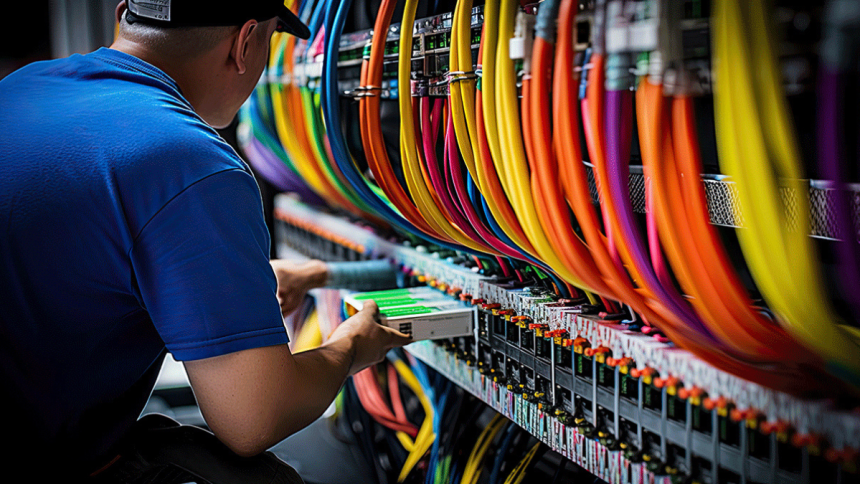In the modern workplace, technology is everywhere—but the systems that hold it together are often invisible.
Every security camera, access badge, network login, and smart sensor depends on something many people never see: structured cabling. It runs through ceilings and under floors, hiding behind walls and server closets, quietly enabling everything from real-time surveillance to seamless IT support.
Structured cabling is the nervous system of your building. And like the nerves in the human body, when it works, you hardly notice it. But when it’s poorly designed or outdated, the entire organism—your network, your operations, your security—starts to break down.
What Is Structured Cabling, Really?
At its core, structured cabling is a standardized system of wiring and components that supports all of a building’s digital infrastructure. Unlike the chaotic tangle of wires you might find in legacy setups, structured cabling is organized, color-coded, labeled, and designed for scalability.
Its job is simple: transmit data. Its impact, however, is massive.
Structured cabling connects:
- Access control systems that determine who enters the building
- Security cameras that monitor activity in real time
- IT networks that handle data, communications, and operations
- Audio-visual systems for conferencing and signage
- Power over Ethernet (PoE) devices like smart lighting and badge readers
Without reliable cabling, none of these systems can communicate clearly or consistently.
Why the Cabling Layer Matters More Than Ever
As businesses adopt more connected devices and smart technologies, the strain on physical infrastructure increases. Each new endpoint—from a conference room camera to a biometric access panel—requires reliable data flow. And that flow travels through the cable.
Poorly installed or outdated cabling systems slow down communication, introduce lag in surveillance feeds, and create security vulnerabilities. In high-demand environments, these issues compound quickly. A delay of even a few seconds between a camera and a command center can make a critical difference.
That’s why structured cabling is more than just a technical requirement—it’s a business-critical asset.
The Intersection of Cabling and Security
Security professionals often talk about layers of protection—access control, surveillance, monitoring, policies—but few emphasize the foundation that holds it all together.
A secure access control system means little if its wiring is exposed, tangled, or running through unreliable switches. Security cameras are only as good as the data connection that supports them. And managed IT services cannot fully protect a system that is built on weak physical infrastructure.
Structured cabling plays a central role in securing both data and people. It ensures that every signal is delivered cleanly, every feed is transmitted clearly, and every system operates in sync with the rest.
This isn’t just about speed—it’s about certainty.
Future-Proofing the Workplace
Businesses grow. Technology changes. Needs evolve.
Structured cabling supports that evolution by creating a modular, adaptable foundation. Whether you’re expanding to a new floor, upgrading to cloud-based access control, or deploying more security cameras, a structured cabling system allows you to make changes without tearing everything apart.
That scalability is not only efficient—it’s cost-effective. It reduces downtime, lowers maintenance costs, and makes future upgrades simpler.
A company like Complex Security Solutions, Inc. understands that cabling isn’t an afterthought. It’s the first thought—because a strong foundation makes everything else possible.
Cabling and IT Managed Services: A Crucial Pairing
While structured cabling forms the physical backbone, IT managed services provide the digital oversight that keeps everything running smoothly.
Think of it like this: structured cabling builds the roads, and IT services direct the traffic. One without the other leads to inefficiencies, bottlenecks, and vulnerabilities.
When cabling and IT management work in tandem, businesses benefit from:
- Proactive network monitoring
- Faster identification of physical or logical faults
- More secure data handling across wired devices
- Simplified troubleshooting and upgrades
- Better uptime across security and operational systems
This holistic approach turns infrastructure into intelligence—and infrastructure into peace of mind.
Why Security Cameras Depend on Cabling Quality
Video surveillance is now a high-definition, real-time, cloud-integrated process. But behind every clear video feed is a high-bandwidth cable silently doing its job.
Structured cabling allows security cameras to function without interference or dropout. It delivers power and data simultaneously (especially with PoE setups), which reduces the need for extra power sources and simplifies installation.
More importantly, quality cabling allows footage to be routed and stored efficiently. It supports:
- High frame rates and resolution
- Real-time streaming to remote devices
- Continuous recording without lag
- Smart analytics integration (motion detection, facial recognition)
When something goes wrong with a camera, it’s often not the camera itself—it’s the connection. That’s why getting the cabling right matters from day one.
Making the Invisible, Indispensable
One of the biggest misconceptions in workplace technology is that flashy hardware equals capability. But in truth, even the most advanced device is limited by its weakest connection.
That’s why structured cabling—though out of sight—is central to your business’s ability to function, grow, and adapt.
It touches every system, supports every signal, and underpins every decision. And when installed with precision, it requires almost no attention. That’s its power. Its quiet brilliance.
Final Thought: Build Strong So You Can Scale Smart
In business, there are things you can fix later—and things you get right the first time.
Structured cabling falls firmly into the latter. When done right, it unlocks the full potential of your access control systems, your security cameras, and your managed IT strategy. It turns every piece of technology into part of a bigger, better whole.
The best part? Once it’s in place, it simply works.
That’s what makes structured cabling the unsung hero of business security—and one of the smartest investments any company can make.
Lynn Martelli is an editor at Readability. She received her MFA in Creative Writing from Antioch University and has worked as an editor for over 10 years. Lynn has edited a wide variety of books, including fiction, non-fiction, memoirs, and more. In her free time, Lynn enjoys reading, writing, and spending time with her family and friends.















